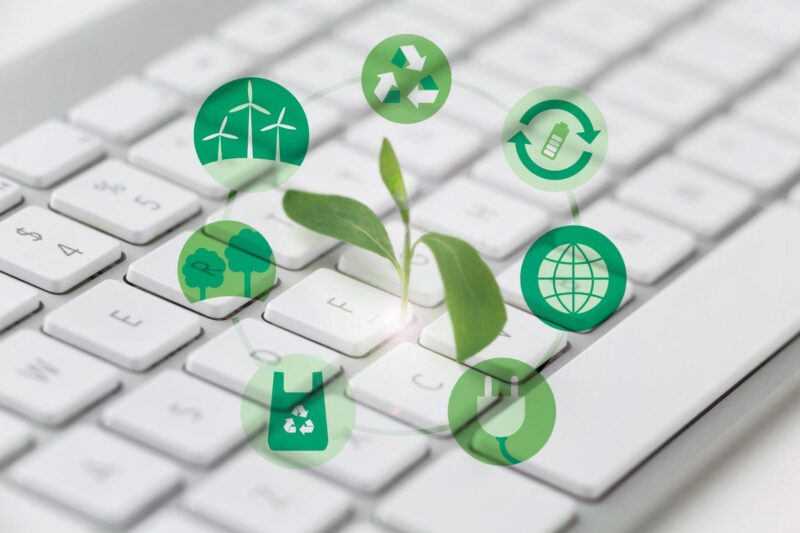Sustainability and environmental care are common themes on business agendas. Many companies strive to reduce their carbon footprint and become more sustainable, both for social responsibility and the business advantages it brings.
The software industry plays an increasingly significant role in global GHG (greenhouse gas) emissions due to rising energy consumption, much of which is generated from fossil fuel combustion with high carbon dioxide (CO2) emissions.
This is where Green Software comes in—a concept referring to IT systems and applications that are developed, implemented, and used with the goal of minimizing their environmental impact while maximizing their social benefits.
This entails optimizing resource usage, reducing carbon emissions, and adopting efficient development practices. Developers can contribute to sustainability by using energy-efficient servers, adopting virtualization and cloud deployment, and optimizing code to reduce energy consumption.
It’s important to raise awareness among internal and external teams on this principle. Regular training sessions can ensure that everyone involved understands the importance of Green Software, especially during periods of staff augmentation.
Principles of Green Software

The Green Software movement is led by the Green Software Foundation, which aims to “build a network of people, standards, tools, and best practices for green software.” They have established a set of eight principles.
These principles consist of key concepts that “green software engineers” should follow. They apply across all sectors, company types, and programming languages, aiming to create a common framework for green coding.
- Carbon: Create valuable programs for users that produce fewer carbon emissions.
- Electricity: Prioritize energy efficiency and low-carbon energy sources.
- Carbon intensity: Measure the emissions generated per kilowatt-hour, consuming electricity with the lowest carbon intensity possible.
- Embedded carbon: Refers to carbon generated in the creation and disposal of electronic devices. Software can help by, for example, keeping older devices updated.
- Energy proportionality: Relates to the relationship between device usage and electricity consumption, aiming to maximize hardware energy efficiency.
- Networks: Reduce carbon emissions from network-connected devices by lowering data quantity or size and shortening data travel distances.
- Demand adaptation: This principle involves doing more (using more energy and computing resources) when there is more energy from low-carbon sources and conserving energy when high-carbon sources are more prevalent.
- Measurement and optimization: Employ optimization strategies that are beneficial in the long term.
Benefits of Green Software

This approach seeks not only to meet current needs but also to preserve resources and minimize negative impacts on the environment and society. Key benefits of Green Software include:
- Reduced environmental impact: Sustainable practices minimize energy consumption, resource use, and e-waste generation. This includes optimizing algorithms, designing efficient software, and implementing energy-saving strategies.
- Resource savings: Sustainable software development promotes efficient use of resources like energy and hardware, potentially reducing server and device resource consumption and lowering operational costs.
- Enhanced efficiency: Sustainable software tends to be more efficient in performance and resource usage, meaning applications run faster and require less processing power.
- Cost savings: Energy efficiency and resource optimization can lower operating expenses and reduce infrastructure-related costs.
- Improved corporate image: Customers and clients increasingly value sustainable practices, which can translate to a competitive advantage and enhance the company’s reputation.
- Compliance with environmental regulations: In many regions, there are environmental regulations requiring companies to reduce their carbon footprint and minimize environmental impact. Sustainable software development helps organizations meet these regulations and avoid legal penalties.
- Facilitates the adoption of emerging technologies: Technologies like cloud computing, virtualization, and mobility increase the flexibility and scalability of IT operations.
- Longer software lifecycle: Sustainable applications tend to last longer, as they are designed to be upgradable and adaptable, saving resources and money.
- Cleaner code: Efforts to reduce and optimize code lead to cleaner code, benefiting not only the application’s performance but also the team, as it simplifies the implementation of corrections and changes.
Vetted and Sustainable Developers
Yes, that you hire vetted developers is crucial, but today, that might not be enough. Consumers increasingly demand environmental responsibility, making it essential for software developers to be sustainable.
Developers have the power to create applications that are both efficient and environmentally friendly. Building a responsible future is possible. Using technology to improve people’s quality of life and preserve the planet is a responsibility for everyone involved in these processes.
As environmental awareness and social responsibility grow, sustainable software development will become a standard practice in the tech industry. Companies that adopt these principles will not only contribute to the planet’s well-being but will also be more competitive in an ever-evolving world.








